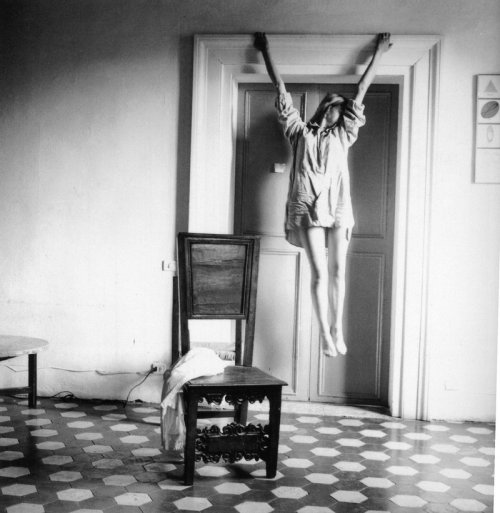Francesca Woodman’s Enduring Appeal

Francesca Woodman’s Enduring Appeal
When she took her life by jumping out a Manhattan loft window in 1981 at just 22, photographer Francesca Woodman left behind a prodigious body of work. And not surprisingly, it is difficult to read her work separate from the story of her short life. C. Scott Willis’ documentary The Woodmans (playing at the Film Forum in New York until February 1) aims to go further by investigating not just Woodman, her journal and her photographs, but also her family—a family of disciplined, loving and competitive artists.
In the film, parents Betty and George Woodman stress that their daughter’s photos are merely genius on their own, and more importantly, that there is nothing dark about them. She felt joy from the vision she communicated, and recognized her depression only when she wasn’t producing. In her characteristic black and white nude self-portraits, Woodman challenges the borders of her surroundings by merging with them—be it the wall or bathtub, or even the wall or light around her. When Woodman selectively covers her nude body in peeling wallpaper as if it’s lingerie, or hangs from a doorframe, it is illuminating to know she was a force of a young woman, and not a sad one. To know her more than just her work or the story of her death, is to really appreciate her.
Woodman was also a lover of fashion. In the film, her father tells of her first drawings—copied from portraits elaborately costumed women, such as Velazquez’ Las Meninas. This translated to her personal style. When she is not nude in her photos, she is wearing statement frocks and has a pile of unkempt hair. She is described as having a “rock star” quality among her school peers, and a bevy of characters remember her for her intense sexuality, or wearing her “skin inside out.” During her time studying abroad in Italy, the film notes how she was noticed for the striking contrast between her yellow-blonde hair and black fur coat.
We learn that once Woodman graduated form RISD and moved to New York, she searched for work in the fashion photography world, and began by loading film as an assistant. Photo rep Glenn Palmer-Smith recalls a memory of meeting her: “So here I am, I’m spending my life addressing the ego of an Italian fashion photographer, meanwhile in the studio here’s one of the great photographers of the twentieth century under everyone’s nose.”
The photograph is the ultimate medium for recording fashion—it captures an ideal, specific moment in time. Sometimes those moments become contemporary classics, and if you stare at them hard enough, they move. As Woodman wrote, “I wish I could change minds as easily as I change socks. But then I don’t change socks so easily.”photo credit: Untitled (1977-78, Rome) by Francesca Woodman
Comments